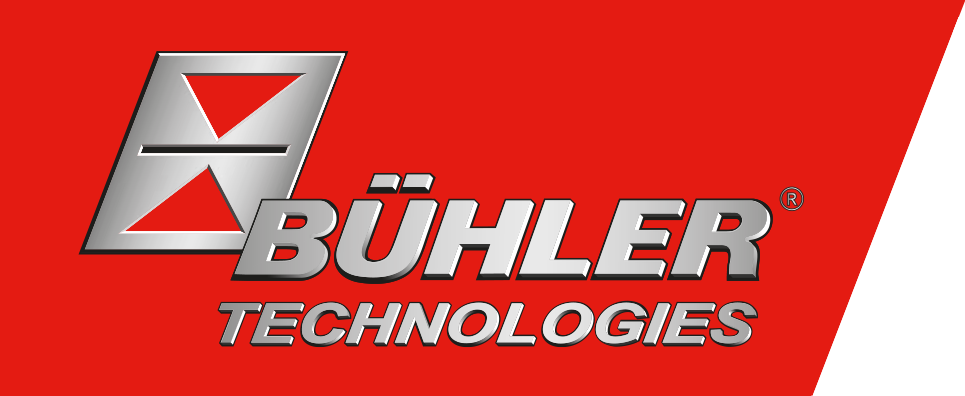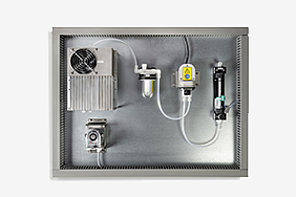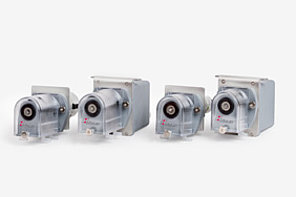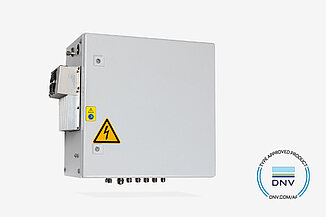With Components from Bühler Technologies – Clear Sailing for Maritime Shipping, Clear Sailing for Environmental Protection...

14/04/2025
Since January 1, 2020, exhaust gas cleaning has been mandatory for seagoing vessels using heavy fuel oil. The monitoring of emissions from these systems is also required. Bühler Technologies provides certified components from classification body for these monitoring systems.
As part of the IAPP (International Air Pollution Prevention) efforts to reduce emissions of CO₂ and other pollutants, international maritime shipping is becoming increasingly regulated. This is due to the fact that large seagoing vessels primarily use high-sulfur heavy fuel oil (HSFO) as fuel, significantly contributing to global air pollution.
To mitigate these pollution sources, the IMO (International Maritime Organization) has long been implementing legally binding emission limits for air pollutants, similar to regulations for land-based power plants. Additionally, several coastal regions in America, Europe, and Asia have enacted even stricter emission limits, prohibiting ships that fail to comply from entering their territorial waters and ports. National authorities monitor emissions using so-called "sniffers" from the air or at stationary points such as bridges and port facilities.
Since January 1, 2020, the SO₂ limit in international waters has been set at 0.50%, while in coastal waters (ECAs = Emission Control Areas), the limit is 0.10%. ECAs include, for example, the North Sea and the Baltic Sea.
To help shipping companies comply with the new limits, regulations allow for various options. These include switching to alternative fuels such as MGO (Marine Gas Oil) or LNG (Liquid Natural Gas), as well as retrofitting or equipping ships with desulfurization systems, known as SOx scrubbers.
These scrubbers offer shipping companies the advantage of continuing to use the significantly cheaper HSFO in their existing propulsion systems, while keeping investment and operating costs manageable compared to MGO or LNG.
Similar to desulfurization systems in stationary power plants, scrubbers function as air scrubbers. The open-loop process utilizes the alkalinity of seawater to neutralize sulfur from engine exhaust gases. Less common are the closed-loop and dry scrubber systems, as well as hybrid systems that combine both. These closed-loop systems use chemicals and minerals to remove sulfur from exhaust gases.
To meet regulatory requirements and obtain the necessary certifications, all scrubber systems must be equipped with certified emissions monitoring systems. These continuously measure compliance with SO₂ and CO₂ limits and provide the required documentation, which must be presented when entering ECAs and ports. The documentation also includes the proper disposal of residues generated during the desulfurization process.
As is common practice in the maritime industry for insurance reasons, all components and devices used in scrubber systems must be certified by an internationally recognized classification society. Approval tests take into account the specific operating conditions on ships and climatic environments. Components must withstand vibrations of up to 4g depending on their location, and their electromagnetic emissions must not interfere with onboard systems or sensors.
The components and systems used for emissions monitoring are also subject to these stringent requirements.
As with land-based applications, the scope of emissions monitoring depends on the type of exhaust systems being controlled and typically includes the following components:
A heated gas sampling probe continuously extracts a gas sample (measurement gas) from a suitable point in the exhaust system. To prevent disruptive condensation, the measurement gas is then transported via a heated gas line to the analysis system. This system consists of two functional stages:
The first stage is the gas conditioning system. It includes a fine filter to remove any particles present in the gas stream, a gas pump that transports the sample from the probe to the analysis system, and, in Bühler Technologies' systems, a two-stage gas cooler that "dries" the gas. This means that the moisture contained in the gas is condensed by lowering the temperature below the dew point and is then removed using condensate pumps. A humidity sensor monitors the degree of drying after the cooler. Finally, an electrically monitored flow meter regulates the correct flow rate for the analyzer in the second stage.
Gas drying is a critical step. It must not alter the composition of the sample gas while ensuring that moisture is effectively removed. Different technologies are used for this, including copolymer membranes, semiconductor (Peltier) coolers, and compressor coolers. When selecting equipment, the specific conditions onboard ships must be considered. The availability of consumables and air purity requirements for copolymer membranes can lead to high operating costs. Compressor coolers that are not rigorously designed may incur significant maintenance costs due to their sensitivity to vibrations and high self-heating. Additionally, as ships travel through various climate zones, gas coolers must offer stable dew point control and low operating costs to ensure reliable measurements. Only the combination of good gas flow and high thermal stability of the measurement gas cooler can yield reliable measurement results. Specially designed Peltier coolers suitable for high ambient temperatures should be the preferred choice.
Even after treatment through scrubbers, high-sulfur fuel oil (HSFO) still contains a significant amount of particulate matter, necessitating thorough pre-filtration to ensure accurate measurements by the gas analysis system. Additionally, regular and proper replacement of filter elements in gas probe can effectively maintain filtration performance and ensure stable pressure and flow within the analysis system. To this end, the gas probe should be equipped with high-quality filter elements designed for quick, tool-free, one-handed replacement, thereby reducing operators’ working time in high-temperature environments and safeguarding their health.
All components and systems used in this analysis system must be tested and certified according to MEPC.259(68) and MARPOL Annex VI.
In propulsion systems with multiple exhaust sources, the analysis system can also be equipped to monitor these individual sources. For this purpose, a measuring point switch is integrated into the first stage behind the gas cooler. Up to three additional measurement gas lines can be connected to this switch.
For metrological and economic reasons, these additional gas lines are only partially equipped with heated lines. Each of these lines has its own gas cooler near the sampling point, with only the section between the sampling probe and the cooler being heated. From the cooler to the measuring point switch, simple gas lines are sufficient.
A connection for flushing the conditioning system with instrument air is located before the gas cooler. The connection for supplying test or zero gas for analyzer calibration is positioned between the two cooling stages of measurement gas line one.
Below is an overview of the application-specific devices developed and certified by Bühler Technologies for this field of application:






![[Translate to English:] [Translate to English:]](/fileadmin/images/gasanalysis/products/sample_gas_pumps/Messgaspumpe-P1.1_th.jpg)
![[Translate to English:] [Translate to English:]](/fileadmin/images/gasanalysis/products/sample_gas_coolers/csm_gaskuehler-gas-cooler-tc-KITplus_1e51f2a245.jpg)
![[Translate to English:] [Translate to English:]](/fileadmin/_processed_/e/7/csm_tn_feinfilter_agf_pv_30_54676c6d78.jpg)
![[Translate to English:] [Translate to English:]](/fileadmin/_processed_/4/c/csm_tn_sm6_sm6v_82077fb635.jpg)